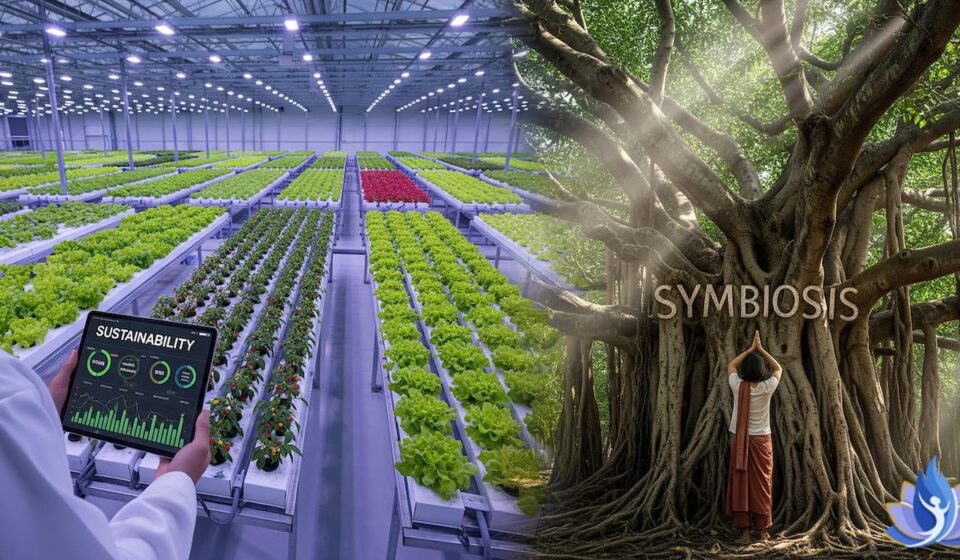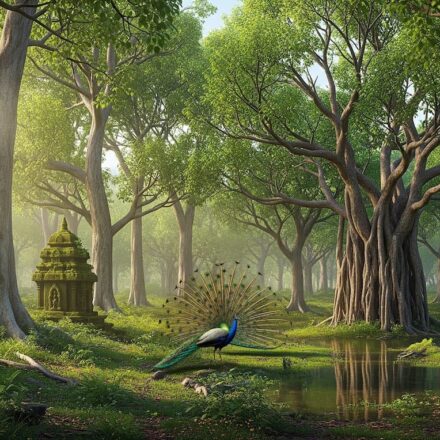
Forget ‘Sustainability’: Ancient India’s Radical Plan for Planetary Symbiosis
The word “sustainability” is everywhere. We talk about sustainable business, sustainable agriculture, and sustainable living. The concept, famously defined as meeting the needs of the present without compromising the ability of future generations to meet their own needs, has become the cornerstone of the modern environmental movement. It’s a noble goal, but what if it’s also a limited one? What if the very framework of sustainability, with its focus on resource management and future human utility, keeps us trapped in the same mindset that created the ecological crisis?
Ancient Indic wisdom offers a more radical and profound alternative. It doesn’t just ask us to “sustain” the planet; it invites us into a relationship of deep, reciprocal symbiosis. This isn’t a plan based on managing a collection of external resources. It’s a spiritual and ethical framework built on the understanding that we are not separate from nature, but an inseparable part of a living, conscious cosmos. This is a plan for planetary healing that goes far beyond the limits of sustainability.
From Resource Management to Sacred Relationship
The modern concept of sustainability is inherently human-centric. It positions humanity as the manager of Earth’s resources, tasked with ensuring there’s enough to go around for future generations. While pragmatic, this view still treats nature as an object—a storehouse of assets to be carefully audited and allocated.
The Vedic worldview completely dissolves this separation. A core principle is Vasudeva Sarvam—the divine is present in all beings. The scriptures teach that the universe is not a collection of disparate objects but a single, unified whole,emanated from and embodied by the Divine. From this perspective, there is no essential separation between humans and nature. Harming a forest or polluting a river is not just an ecological misstep; it is a form of self-harm, a violation of the sacred unity of life. This shifts the goal from managing an external resource to nurturing a sacred relationship with an extended part of ourselves.
The Earth as Mother, Not as an Asset
A key part of this relational shift is the personification of the Earth as a goddess, Bhumi Devi, our Mother. The ancient Bhumi Sukta hymn describes her as the one who nourishes and supports all her children without discrimination. This is a stark contrast to the modern economic view of Earth as a natural asset on a global balance sheet.
One does not seek to “sustain” one’s mother for future utility; one loves, respects, and serves her out of a sense of sacred duty, or Dharma. This reframes our entire purpose. Our obligation is not to manage the planet for our own survival, but to live in a way that honors and cares for the divine mother who gives us life. This is the foundation of a symbiotic, not a utilitarian, relationship.
Yajna: The Cosmic Law of Reciprocity
How is this symbiotic relationship maintained? The Bhagavad Gita introduces the concept of Yajna, often translated as sacrifice, but more accurately understood as a cosmic principle of selfless, reciprocal action. It teaches that the universe functions through a continuous cycle of giving and receiving. The sun gives light, the clouds give rain, the earth gives food, and in return, human beings have a duty to perform actions that nourish and uphold this cosmic order.
This is the engine of planetary symbiosis. Our actions should not be focused solely on taking what we need, but on giving back to the system that sustains us. This principle moves beyond simply reducing our negative impact and calls for us to make a positive contribution. It is an active, participatory role in maintaining ecological balance, a core tenet of what many now call regenerative culture.
The Inner Shift: From a Higher Standard of Living to a Higher Quality of Life
Ultimately, the Vedic plan for symbiosis recognizes that the outer ecological crisis is a reflection of an inner spiritual crisis: insatiable human desire. A system based on endless growth and consumption is fundamentally at odds with a finite living planet.
The solution, therefore, is an ideological change that prioritizes appreciating the quality of life over simply pursuing a higher standard of living. This is where the yogic principles of Ahimsa (non-harming) and Aparigraha (non-possessiveness) become powerful tools for ecological action. By cultivating contentment and minimizing harm in all our actions—from the food we eat to the products we buy—we address the root cause of the crisis. This internal shift is the most radical and effective step toward a symbiotic existence.
Conclusion: A More Beautiful Vision
“Sustainability” is a call to do less harm. The ancient Indic vision of symbiosis is a call to actively participate in the flourishing of all life. It asks us to move beyond the cold calculus of resource management and into a warm, living relationship with a sacred Earth. It is a plan that requires not just new technologies, but a new consciousness—one rooted in reverence, duty, and a profound understanding of our place within the cosmic family. This is the radical, ancient plan that offers a path not just to survival, but to a truly inspired and harmonious existence.
If this article offered you a new perspective, please share it with someone who might find it valuable. Spreading this ancient wisdom is a step toward a more conscious world. For more insights that connect timeless knowledge with modern life, follow us on our social media channels and continue exploring at aninspiredsoul.com










